Search the Special Collections and Archives Portal
Search Results
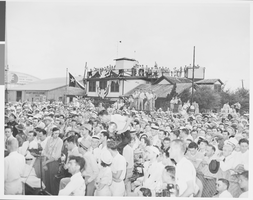
Photograph of crowds at parade for Howard Hughes, Chicago, 1938
Date
1938
Archival Collection
Description
A view of crowds and the press at a parade for Howard Hughes celebrating the flyer's completion of his Round-The-World trip in Chicago.
Image
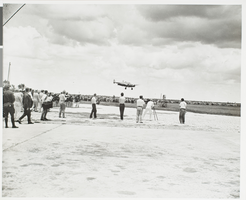
Photograph of the Lockheed 14 aircraft landing, Chicago, 1938
Date
1938
Archival Collection
Description
A view of crowds and the press watching Howard Hughes and his crew land the Lockheed 14 aircraft in Chicago.
Image
Stardust Gambling Museum news segments: video
Date
1987-05-08 to 1987-05-09
Archival Collection
Description
Local news segments on the Stardust's "old-time gambling museum" which houses a $3 million dollar collection put together by Boyd Gaming and part of a larger renovation. First segment interviews Ralph Purnell, Stardust General Manager, who explains why the museum was put together as a new attraction, comparing it to Imperial Palace's car collection. In the second segment, Sam Boyd is seen leading the first tour through the museum. A brief history is provided on gaming and gambling, while stills of early Las Vegas are shown. Purnell speaks again on why the museum was created. The third segment the interior of the museum and artifacts around the museum. Interview with E. J. Cummins talks about hiding these artifacts while it was illegal, and the reporter speaks with historians about various early gaming machines. Original media VHS, color, aspect ratio 4 x 3, frame size 720 x 486. From the Stardust Resort and Casino Records (MS-00515) -- Photographs and audiovisual material -- Digitized audiovisual material file.
Moving Image
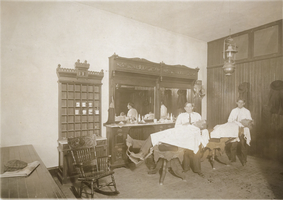
Photograph of Dofflemyre and Lake at a barbershop in Las Vegas, circa 1900s
Date
1905 to 1939
Archival Collection
Description
Black and white image of Dofflemyre (left) and Lake (right) at a barbershop at the corner of Fremont and Main Streets where the Hotel Nevada was once located.
Image
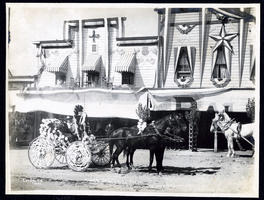
Photograph of a decorated wagon at Tonopah Railroad Carnival, Tonopah (Nev.), early 1900s
Archival Collection
Description
Caption: Miners Drugstore Float Tonopah R.R. Carnival
Image
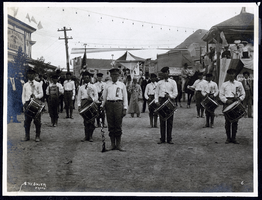
Photograph of Tonopah Railroad Carnival marching band, Tonopah (Nev.), early 1900s
Date
Unknown year in the decade of the 1900s
Archival Collection
Description
Photograph of Tonopah Railroad Carnival marching band, Tonopah (Nev.), early 1900s
Image
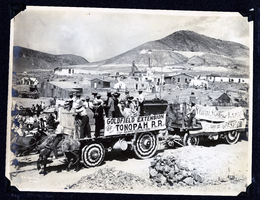
Photograph of advertisements on ore wagons at Tonopah Railroad Carnival, Tonopah (Nev.), early 1900s
Date
Unknown year in the decade of the 1900s
Archival Collection
Description
Photograph of advertisements on ore wagons at Tonopah Railroad Carnival, Tonopah (Nev.), early 1900s
Image
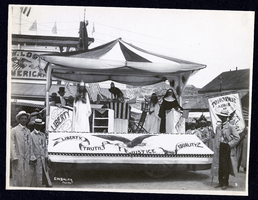
Photograph of Fraternal Order of Eagles Aerie Float at Tonopah Railroad Carnival, Tonopah (Nev.), early 1900s
Date
Unknown year in the decade of the 1900s
Archival Collection
Description
Photograph of Fraternal Order of Eagles Aerie Float at Tonopah Railroad Carnival, Tonopah (Nev.), early 1900s
Image
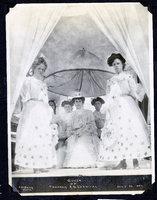
Photograph of Queen and Court of Tonopah Railroad Carnival, Tonopah (Nev.), early 1900s
Date
1904-07-25
Archival Collection
Description
[Miss Belle Pepper was crowned]
Caption: Queen of Tonopah R.R. Carnival
Caption: Queen of Tonopah R.R. Carnival
Image
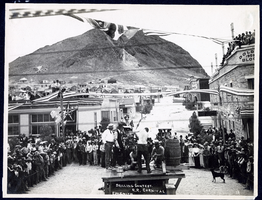
Photograph of a double handed drilling contest in downtown Tonopah (Nev.), early 1900s
Archival Collection
Description
Drilling Contest Tonopah Railroad Carnival
Image
Pagination
Refine my results
Content Type
Creator or Contributor
Subject
Archival Collection
Digital Project
Resource Type
Year
Material Type
Place
Language
Records Classification
